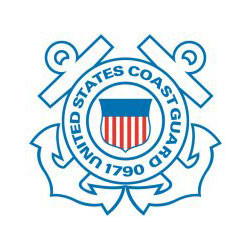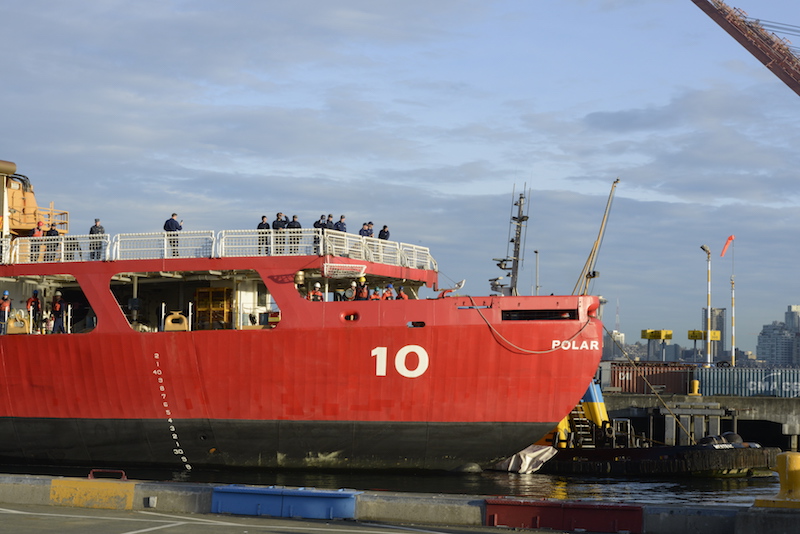The 150-member crew of the U.S. Coast Guard cutter Polar Star returned Monday to their homeport of Seattle following a 105-day deployment to Antarctica in support of Operation Deep Freeze.
Operation Deep Freeze is an annual joint military service mission in support of the National Science Foundation, the lead agency for the United States Antarctic Program. Since 1955, the U.S. Department of Defense and the Coast Guard have assisted in providing air and maritime support throughout the Antarctic continent.
This year marks the 63rd iteration of the annual operation. The Polar Star crew departed Seattle on Nov. 27 for their sixth deployment in as many years and traveled 11,200-nautical-miles to Antarctica.
Upon arrival in McMurdo Sound, Antarctica, the Polar Star broke through 16.5 nautical miles of ice, six to 10 feet thick, in order to open a channel to the pier at McMurdo Station. Once the channel was open, the crew refueled Polar Star at McMurdo Station, the United States’ main logistics hub in Antarctica. At the conclusion of a three day port visit to McMurdo Station the ship provided a six-hour familiarization cruise to 156 McMurdo station personnel.
On Jan. 30, the Polar Star escorted the container ship Ocean Giant through the channel, enabling a 10-day offload of 499 containers with 10 million lbs. of goods that will resupply McMurdo Station, Amundsen-Scott South Pole Station and other U.S. field camps for the coming 12 months. The Ocean Giant is an ice strengthened vessel contracted by the U.S. Navy’s Military Sealift Command for Operation Deep Freeze.
As in years past, getting the 43-year-old Polar Star to Antarctica was accomplished despite a series of engineering casualties aboard the ship. Commissioned in 1976, the cutter is operating well beyond its expected 30-year service life. It is scheduled for a service life extension project starting in 2021.
During the transit to Antarctica, one of the ship’s electrical systems began to smoke, causing damage to wiring in an electrical switchboard, and one of the ship’s two evaporators used to make drinkable water failed. The electrical switchboard was repaired by the crew, and the ship’s evaporator was repaired after parts were received during a port call in Wellington, New Zealand.
The impact from ice operations ruptured the cutter’s centerline shaft seal, allowing water to flood into the ship. Icebreaking operations ceased so embarked Coast Guard and Navy divers could enter the water to apply a patch outside the hull so Polar Star’s engineers could repair the seal from inside the ship. The engineers donned dry suits and diver’s gloves to enter the 30-degree water of the still slowly flooding bilge to effect the vital repairs. They used special tools fabricated onboard to fix the leaking shaft seal and resume ice breaking operations.
The Polar Star also experienced ship-wide power outages while breaking ice in McMurdo Sound. Crewmembers spent nine hours shutting down the ship’s power plant and rebooting the electrical system in order to remedy the outages.
On Feb. 10, the crew spent nearly two hours extinguishing a fire in the ship's incinerator room while the ship was approximately 650-nautical-miles north of McMurdo Sound, Antarctica. The fire damaged the incinerator and some electrical wiring in the room was damaged by fire fighting water. There were no personnel injuries or damage to equipment outside the space. Repairs to the incinerator are already scheduled for Polar Star’s upcoming inport maintenance period.
Presently, the Coast Guard maintains two icebreakers – the Coast Guard cutter Healy, which is a medium icebreaker, and the Polar Star, the United States' only heavy icebreaker. If a catastrophic event, such as getting stuck in the ice, were to happen to the Healy in the Arctic or to the Polar Star near Antarctica, the Coast Guard is left without a self-rescue capability.
By contrast, Russia currently operates more than 50 icebreakers – several of which are nuclear powered.
Reserved for Operation Deep Freeze each year, the Polar Star spends the Southern Hemisphere summer breaking ice near Antarctica, and when the mission is complete, the Polar Star returns annually to drydock in order to complete critical maintenance and repairs in preparation for the next Operation Deep Freeze mission. Once out of drydock, the ship returns to Antarctica, and the cycle repeats.
The Coast Guard has been the sole provider of the nation’s polar icebreaking capability since 1965, and is seeking to increase its icebreaking fleet with six new polar icebreakers in order to ensure continued national presence and access to the Polar Regions.
In the fiscal year 2019 budget, Congress appropriated $655 million to begin construction of a new polar security cutter this year, with another $20 million was appropriated for long-lead-time materials to build a second.
In response to the demands of the region, the service is set to release an updated version of its Arctic Strategy, which Adm. Karl Schultz, the commandant of the Coast Guard, is scheduled to discuss March 21 during his annual State of the Coast Guard Address.
“The Coast Guard greatly appreciates the strong support from both the administration and Congress for funding the polar security cutter program,” said Schultz. “These new cutters are absolutely vital to achieving our national strategic objectives in the Polar Regions – presence equals influence, and we must be present to meet the Nation’s national security and economic needs there in the future.”




